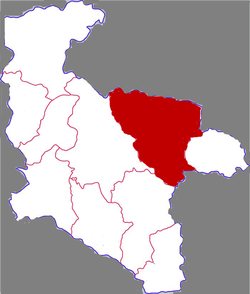Top Qs
Timeline
Chat
Perspective
Xunyang, Shaanxi
County-level city in Shaanxi, People's Republic of China From Wikipedia, the free encyclopedia
Remove ads
Xunyang (simplified Chinese: 旬阳市; traditional Chinese: 旬陽市; pinyin: Xúnyáng Shì; formerly written as (Chinese: 洵陽) until 1964)[1] is a county-level city in the south of Shaanxi province, China, bordering Hubei province to the northeast and southeast. It is under the administration of the prefecture-level city of Ankang. Its administrative seat is in the town of Chengguan.[2]
The county covers an area of 3,540.8 square kilometres (1,367.1 sq mi),[2] and has a population of 450,122 as of 2019.[3]
Remove ads
History
During the Spring and Autumn period, the area of present-day Xunyang County belonged to the State of Chu.[4] In the Warring States period, the area was incorporated as Xunyang County.[4] In 312 BCE, Xunyang County was taken by the State of Qin following the Battle of Danyang and Lantian.[4]
Later, the area became part of the Han Dynasty, where it was placed under the Hanzhong Commandery.[4] During the Qing Dynasty, the area belonged to the Xing'an Fu.[4]
From 1914 to 1928, the area belonged to Hanzhong Circuit.[4] From 1928 to 1949, the area was directly administered by Shaanxi Province.[4]
Since the establishment of the People's Republic of China in 1949, the county has belonged to Ankang.[4] In 1964, its name was changed from Xunyang County (Chinese: 洵阳县; pinyin: Xúnyáng Xiàn) to Xunyang County (Chinese: 旬阳县; pinyin: Xúnyáng Xiàn), due to the uncommon nature of the previous first character.[4]
Remove ads
Geography
Summarize
Perspective
Xunyang is located in the Shaanan region, approximately 220 kilometres (140 mi) from Xi'an.[2] To the county's north lies the Qinling Mountains.[2]
The Han River flows through the county, as well as a number of its tributaries, such as the Xun River, the Xian River, the Shen River, the Lengshui River, the Zhutong River, the Xicha River, and the Shu River.[2]
Climate
Xunyang County has an average annual precipitation of 777 millimetres (30.6 in).[2]
Remove ads
Government
In 2019, the county government earned ¥1.877 billion in fiscal revenue, and spent ¥3.994 billion in fiscal expenditures.[7]
Administrative divisions
As of 2020, Xunyang County is divided into 21 towns.[8]
|
|
|
Remove ads
Demographics
As of 2019, Xunyang County has a population of 450,122 people, who reside in 149,961 households.[3] The county's dominant ethnicity is Han, but populations of Hui, Manchu, Korean, Tujia, Nakhi, Mongol, Miao, Kam, and Yi people reside within the county.[3]
Economy
In 2019, Xunyang County reported a gross domestic product (GDP) of ¥18.705 billion, an 8.4% annual increase.[7] The county's per capita GDP rose 8.0% to ¥42,982.[7] 10.6% of the county's GDP came from its primary sector, 52.5% came from its secondary sector, and 36.9% came from its tertiary sector.[7] The county's public sector accounted for 41.9% of its GDP.[7]
Agriculture
The county's main agricultural products include various grains, oils, tobacco, and vegetables.[7] In 2019, the county had about 1 million heads of poultry, 205 thousand heads of swine, 134 thousand heads of goats, and 67 thousand heads of cattle.[7] The county also has sizable aquaculture and forestry industries.[7]
Industry
Major industries in Xinyang County include the production of medicine, cement and building materials, hydropower, equipment manufacturing, tobacco, food products, and mining.[7] Xunyang County is home to deposits of mercury, antimony, aluminum, zinc, gold, barite, and slate.[2]
Retail
In 2019, the county experienced a total of ¥5.757 billion in consumer retail sales.[7]
Remove ads
Transport
Road
National Highway 316 passes through the county.[2] The Xikang Expressway, part of the G65 Baotou–Maoming Expressway, passes through the county.[citation needed] Shaanxi Provincial Highway 102 also passes through Xunyang County.[citation needed]
Rail
14 train stations serve the county, which is home to 128 kilometers of railroad.[citation needed] The Xiangyang–Chongqing railway passes through Xunyang County,[2] as does the Xi'an–Ankang railway.[citation needed]
Remove ads
Notes
External links
Wikiwand - on
Seamless Wikipedia browsing. On steroids.
Remove ads


